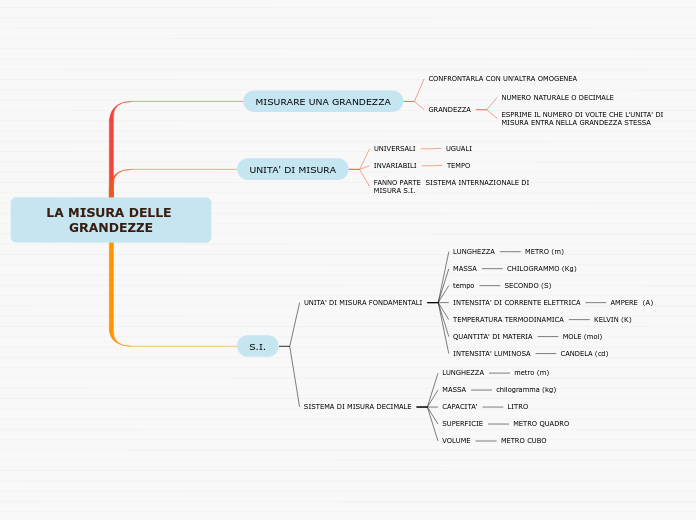LA MISURA DELLE GRANDEZZE
To name your story, you have to think about the overall message and what you want your audience to understand from the story. Also, make it relevant and easy to remember.
S.I.
SISTEMA DI MISURA DECIMALE
VOLUME
METRO CUBO
SUPERFICIE
METRO QUADRO
CAPACITA'
LITRO
chilogramma (kg)
metro (m)
UNITA' DI MISURA FONDAMENTALI
INTENSITA' LUMINOSA
CANDELA (cd)
QUANTITA' DI MATERIA
MOLE (mol)
TEMPERATURA TERMODINAMICA
KELVIN (K)
INTENSITA' DI CORRENTE ELETTRICA
AMPERE (A)
tempo
SECONDO (S)
MASSA
CHILOGRAMMO (Kg)
LUNGHEZZA
METRO (m)
UNITA' DI MISURA
The ending of a story is essential. We all know that if the ending is weak, what happened before loses its importance. So make it unpredictable, but fair. A resolved ending answers all the questions and ties up any loose threads from the plot.
FANNO PARTE SISTEMA INTERNAZIONALE DI MISURA S.I.
INVARIABILI
This is the closure section of the story.
See examples of possible outcomes below:
- all problems have been solved
- it's clear how each one of your characters ends up
- your main character is transformed by the challenge
TEMPO
Try answering these questions to come up with a closure:
- Have all the problems been solved?
- Is there a clear picture of what happens with each character in the story?
- Has the challenge transformed your main character?
- How do the characters feel in the end?
UNIVERSALI
This is the moment when the main character surpasses the last obstacle and finally faces their greatest challenge.
The climax usually follows one of these patterns:
- realization
- resolution
- choice
Type in your answer.
UGUALI
MISURARE UNA GRANDEZZA
In the beginning of the story (or the exposition), you will need to introduce the setting and characters. You might also want to introduce the main conflict. This part of the story is important because it gives the reader necessary background information and maybe even a first insight into a character’s personality.
GRANDEZZA
The setting (time & place) of a story can change throughout the plot.
ESPRIME IL NUMERO DI VOLTE CHE L'UNITA' DI MISURA ENTRA NELLA GRANDEZZA STESSA
The time of the story can also change. It can describe the event of a single day or can include an entire year's plot. Anyway, don't forget to mention it.
NUMERO NATURALE O DECIMALE
Your story can take place wherever your imagination will take you to.
For example: in an elevator, in an enchanted forest, etc. Don't forget to give details of the environment each time the setting changes, otherwise, the story can be confusing. Also, mention the seasons as each of them has unique weather and events.
CONFRONTARLA CON UN'ALTRA OMOGENEA
Characters are essential to a good story. Usually, the protagonist(s) is/are the most affected by the plot. Introduce a character by focusing on their actions, interests, and occupation, as the physical appearance doesn't make a difference in most cases.










